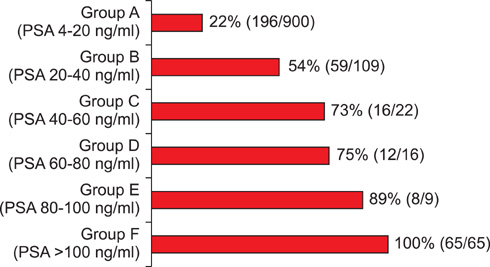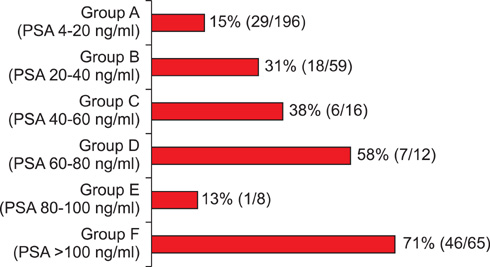Korean J Urol.
2012 Feb;53(2):82-86.
Is Prostate Biopsy Essential to Diagnose Prostate Cancer in the Older Patient with Extremely High Prostate-Specific Antigen?
- Affiliations
-
- 1Department of Urology, Urological Science Institute, Yonsei University Health System, Seoul, Korea. urokim@nhimc.or.kr
- 2Department of Urology, National Health Insurance Corporation Ilsan Hospital, Goyang, Korea.
Abstract
- PURPOSE
The results of all prostate biopsies may be positive and suggestive of adenocarcinoma in patients with prostate-specific antigen (PSA) values higher than 100 ng/ml. We considered that the prostate cancer in patients with high PSA might be advanced disease and therefore that the treatment strategy should not be changed according to pathological reports. Thus, we assessed the role of prostate biopsy when diagnosing prostate cancer in patients with extremely high PSA levels.
MATERIALS AND METHODS
We reviewed the records of 1,150 cases undergoing prostate biopsies. Patients with urinary tract infection and acute urinary retention were excluded. According to the pre-biopsy PSA level, patients were divided into 6 groups (group A, 4 to 20 ng/ml; B, 20 to 40 ng/ml; C, 40 to 60 ng/ml; D, 60 to 80 ng/ml; E: 80 to 100 ng/ml; and F, above 100 ng/ml).
RESULTS
The calculated positive predictive value (PPV) for prostate cancer was 22% in group A, 54% in group B, 73% in group C, 75% in group D, 89% in group E, and 100% in group F, respectively. Pathological diagnosis was adenocarcinoma in all patients in group F (n=56). Among them, 38 patients (67.9%) had lymph node metastasis or extra-prostatic disease or both and 43 patients (76.8%) had bony metastasis. In group F, all cases were advanced prostate cancer (stage III or IV). All of them received hormonal therapy following diagnosis.
CONCLUSIONS
We suggest the possibility for biopsy-free diagnosis of prostate cancer in patients with extremely high levels of serum PSA and evidence of advanced disease in imaging studies, especially in older patients with comorbid medical problems.
Keyword
MeSH Terms
Figure
Reference
-
1. Egawa S, Matsumoto K, Yoshida K, Iwamura M, Kuwao S, Koshiba K. Results of transrectal ultrasound-guided biopsies and clinical significance of Japanese prostate cancer. Jpn J Clin Oncol. 1998. 28:666–672.2. Catalona WJ, Richie JP, Ahmann FR, Hudson MA, Scardino PT, Flanigan RC, et al. Comparison of digital rectal examination and serum prostate specific antigen in the early detection of prostate cancer; results of a multicenter clinical trial of 6,630 men. J Urol. 1994. 151:1283–1290.3. Kim HW, Ko YH, Kang SH, Lee JG. Predictive factors for prostate cancer in biopsy of patients with prostate-specific antigen levels equal to or less than 4 ng/ml. Korean J Urol. 2011. 52:166–171.4. Gerstenbluth RE, Seftel AD, Hampel N, Oefelein MG, Resnick MI. The accuracy of the increased prostate specific antigen level (greater than or equal to 20 ng./ml.) in predicting prostate cancer: is biopsy always required? J Urol. 2002. 168:1990–1993.5. Roberts RO, Bergstralh EJ, Besse JA, Lieber MM, Jacobsen SJ. Trends and risk factors for prostate biopsy complications in the pre-PSA and PSA eras, 1980 to 1997. Urology. 2002. 59:79–84.6. Rodríguez LV, Terris MK. Risk and complications of transrectal ultrasound guided prostate needle biopsy: a prospective study and review of the literature. J Urol. 1998. 160:2115–2120.7. Collins GN, Lloyd SN, Hehir M, McKelvie GB. Multiple transrectal ultrasound-guided prostatic biopsies-true morbidity and patient acceptance. Br J Urol. 1993. 71:460–463.8. Schröder FH, van der Maas P, Beemsterboer P, Kruger AB, Hoedemaeker R, Rietbergen J, et al. Evaluation of the digital rectal examination as a screening test for prostate cancer: Rotterdam section of the european randomized study of screening for prostate cancer. J Natl Cancer Inst. 1998. 90:1817–1823.9. Smith DS, Catalona WJ. Rate of change in serum prostate specific antigen levels as a method for prostate cancer detection. J Urol. 1994. 152:1163–1167.10. Norberg M, Holmberg L, Häggman M, Magnusson A. Determinants of complications after multiple transrectal core biopsies of the prostate. Eur Radiol. 1996. 6:457–461.11. Aus G, Hermansson CG, Hugosson J, Pedersen KV. Transrectal ultrasound examination of the prostate: complications and acceptance by patients. Br J Urol. 1993. 71:457–459.12. Rietbergen JB, Kruger AE, Kranse R, Schröder FH. Complications of transrectal ultrasound-guided systematic sextant biopsies of the prostate: evaluation of complication rates and risk factors within a population-based screening program. Urology. 1997. 49:875–880.13. Gann PH, Hennekens CH, Stampfer MJ. A prospective evaluation of plasma prostate-specific antigen for detection of prostatic cancer. JAMA. 1995. 273:289–294.14. Heyns CF, Naudé AM, Ahmed G, Stopforth HB, Stellmacher GA, Visser AJ. Serum prostate-specific antigen as surrogate for the histological diagnosis of prostate cancer. S Afr Med J. 2001. 91:685–689.15. Kim JW, Lee HY, Hong SJ, Chung BH. Can a 12 core prostate biopsy increase the detection rate of prostate cancer versus 6 core?: a prospective randomized study in Korea. Yonsei Med J. 2004. 45:671–675.16. Shim HB, Lee SE, Park HK, Ku JH. Accuracy of a high prostate-specific antigen level for prostate cancer diagnosis upon initial biopsy in Korean men. Yonsei Med J. 2007. 48:678–683.17. Yang WJ, Lee DH, Chung BH, Cho JS, Choi YD, Kim SJ, et al. Detection rate of prostate cancer on biopsy according to serum prostate-specific antigen in Korean men: a multicenter study. Urology. 2006. 67:333–336.18. Polascik TJ, Oesterling JE, Partin AW. Prostate specific antigen: a decade of discovery-what we have learned and where we are going. J Urol. 1999. 162:293–306.19. Neal DE Jr, Clejan S, Sarma D, Moon TD. Prostate specific antigen and prostatitis I. Effect of prostatitis on serum PSA in the human and nonhuman primate. Prostate. 1992. 20:105–111.20. Dalton DL. Elevated serum prostate-specific antigen due to acute bacterial prostatitis. Urology. 1989. 33:465.21. Aliasgari M, Soleimani M, Hosseini Moghaddam SM. The effect of acute urinary retention on serum prostate-specific antigen level. Urol J. 2005. 2:89–92.
- Full Text Links
- Actions
-
Cited
- CITED
-
- Close
- Share
- Similar articles
-
- The Diagnostic Value of Prostate-specific Antigen and the of Routine Laboratory Examination for Early Detection
- The Prostate Cancer Detection Rate on the Second Prostate Biopsy according to Prostate-Specific Antigen Trend
- High-Grade Prostatic Intraepithelial Neoplasia
- Miliary Tuberculosis Following Transrectal Ultrasonography (TRUS)-Guided Prostate Biopsy
- Change of serum prostate specific antigen values after radiation therapy in prostate cancer



